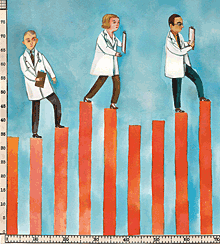Health Reform by the Numbers
By using data to target inefficiencies, leading healthcare systems are proving technology’s potential to revolutionize care delivery.
More than a year after the Affordable Care Act was passed, it is clear that a sweeping policy change will not be enough to repair the U.S. healthcare system. As an industrialist in the healthcare business, I can see that the fundamental driver of high costs and quality issues is the inconsistency of healthcare delivery and outcomes from region to region, state to state, and even hospital to hospital. Such variance is evil: It is bad for your health, it is bad for your local doctor’s business, and it is bad for the healthcare system as a whole. But I also know that the part of the business perceived as less exciting — process and information technology — can drive revolutionary change.
The good news is that certain pioneering institutions are already using IT and process engineering to reduce costs and improve health outcomes. They approach healthcare as a science, not as an art. They’ve used data to target areas of underperformance and waste, and they’ve employed technology to transform their systems. Their solutions can serve as best practices for patients and businesses alike. (Disclosure: GE makes some of the technologies used by these companies.)
Virtua, a comprehensive multi-hospital system based in southern New Jersey, is considered one of the best-performing hospitals in the nation — both clinically and financially. Its leaders accomplished this by using data to understand performance and drive day-to-day process improvements while expanding their technology capabilities at the system’s nine locations. Virtua has seen many changes system-wide, ranging from improving staff scheduling to decreasing by two-thirds the amount of time it takes to treat a woman who discovers a lump in her breast. As a hospital system that generates in excess of US$1 billion in annual revenue, Virtua has been able to save $23 million in unnecessary costs since incorporating Six Sigma as a process improvement tool.
Virginia’s Bon Secours Richmond Health System, which recently announced a data-rich “no-wait emergency room,” has also saved $5 million through technology that enabled the organization to eliminate unnecessary spending on equipment; the health system now deploys 30 percent fewer intravenous pumps alone. And with the use of technology and a strong governance structure, the system estimates that its 20-minute reduction in overall surgical procedure time could expand access to more than 500 additional patients per year.
The Tampa, Fla.–based H. Lee Moffitt Cancer Center and Research Institute, one of the leading cancer centers in the United States, used sophisticated computer modeling to reconfigure its surgical block schedule, freeing up capacity for 900 additional cancer procedures a year without adding operating rooms or hours. That new capacity improves access for patients (up to 12 percent more medical procedures can be performed) and makes good business sense (about an $8 million annual margin for the center).
Sometimes less is more. At Boston’s Brigham and Women’s Hospital, GE is supporting efforts to ensure more appropriate imaging. Software that aggregates decades of evidence-based medical best practices provides diagnostic options based on historical effectiveness and patient history. It may seem counterintuitive for a medical device manufacturer to recommend fewer tests, but this kind of effort has the potential to curb the number of unnecessary imaging tests given at hospitals and outpatient clinics around the world. If you understand variance, you know it goes both ways: For every unnecessary scan out there, somebody who needs one is not getting it. Those undiagnosed patients will inevitably cost more to treat down the road. Managing variance will improve healthcare quality and lower costs at the same time.
These institutions are at the vanguard of healthcare reform, harnessing data in practical ways to breathe new life into the existing system. It’s time to focus on solutions and employ the data, processes, and technologies available today to give doctors, nurses, and all other healthcare providers the best environment in which to perform. We know from extensive industrial experience that total dedication to efficiency will pay off in terms of improved quality, enhanced customer experience, greater patient safety, and reduced costs. Thoughtful leaders will become the heroes of healthcare reform by following the same formula. ![]()

沒有留言:
張貼留言